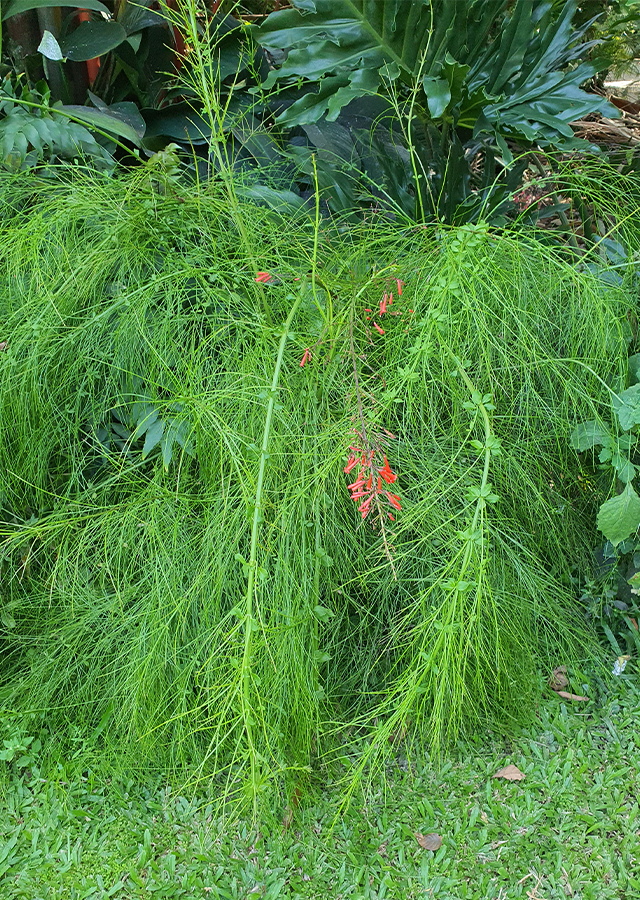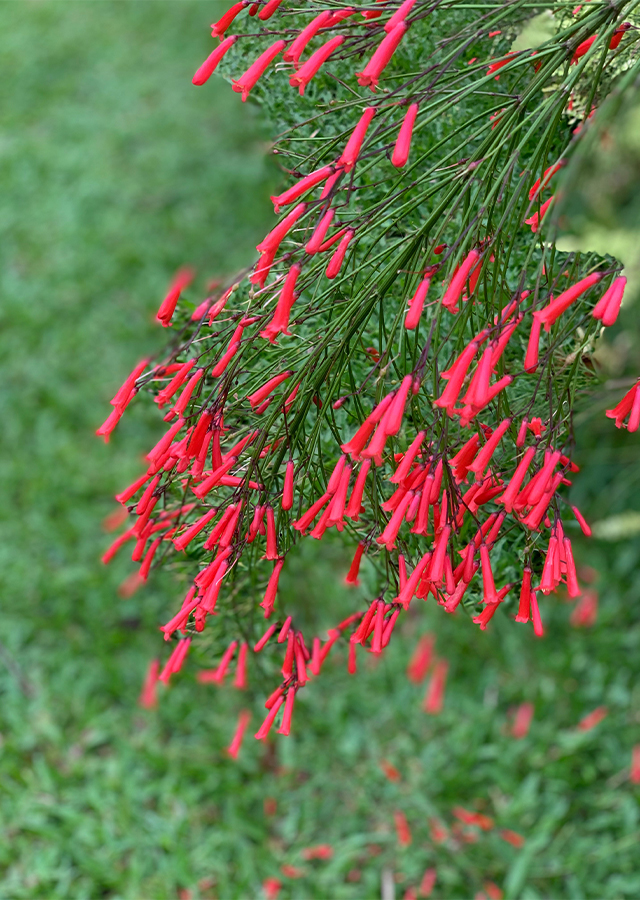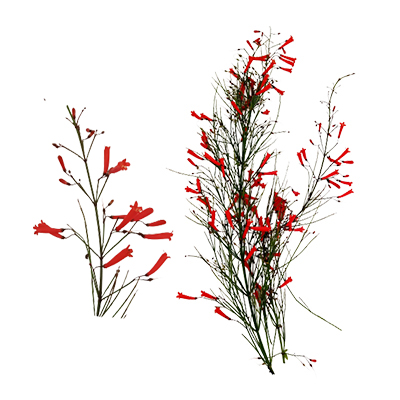Firecracker Plant
Russelia equisetiformis Schltdl. & Cham.
Plantaginaceae
Location in our garden
Principal



Synonym
Russelia juncea Zucc.
Habitus
Shrubs. A perennial shrub growing up to 1 m
Part Used
Flowers
The Whole Plant
Growing Requirements
Full Sunshine
Need Shade
Habitat
Riverbanks
Roadside
Overview
Firecracker plant is native to Mexico, and introduced elsewhere mostly as an ornamental species. A tropical and subtropical plant that is recorded introduced for North America, Central America, the Caribbean, South America, Europe, Africa, Asia and Oceania.
Vernacular Names
Bao zhang zhu (Chinesse), Cola de Caballo (Colombia), Caral de italia (Italian), Russelia-prele ( French), Rasili (Hindi), Cola de Caballo (Mexican), Lagrima de Cupido (Spanish).
Agroecology
Russelia equisetiformis easy to grow, it thrives in full sun or part sun in fertile, medium moisture, well drained soils. The plant can be espaliered on a trellis for vertical display or balcony-terrace screen (in pot). It can withstand temperatures down to -6 °C. However some authorities assert that it cannot tolerate temperature below 5 °C and must therefore be kept under glass during the winter moths.
Morphology
- Stems - tiny, oval and bright green, shrub up to 1,5 m high with numerous lax whorled branches sometimes arching and rooting, ribbed and equisetum-like.
- Leaves - small, linear-lanceolate or ovate and almost scalelike on the branches
- Flowers - red, tubular, 2-lipped, up to 3 cm long and in loose branching clusters. Corolla scarlet, tubular,slighty saccate, up to 2,5 cm long.
- Capsule - globose, 3-6 mm in diameter, seeds small, oval, warty, light brown, among white hairs filling the capsule.
Cultivation
- By stem tip cutting. Choose a healthy tip with a minimal 2 leaves near the end, cutting should be 6 inches long and remove all leaves except a pair at the branch tip. Place the cutting into a pot of approriate, well-draining soil and water lightly.
- Firecracker plants are easily propagated from rooted cuttings.
Chemical Constituents
Alkaloids, flavonoids, saponins, tannins, steroid, terpenoids, hexadecanoic acid methyl ester, methyltetracosane, n-docosane, β-pinene, octadecanoic acid methyl ester.
Traditional Medicinal Uses
Medicinal Uses
- Studies suggest antiinflamation, analgesic, antimicrobial, anticonsulvant, anti diabetic, membrane stabilizing, depressant, anti malarial, hepatoprotective, anthemintic properties.
Traditional Uses
- In Southwestern Nigeria, it used for diabetes and leukimia.
- Used to treat malaria, cancer and inflamatory diseases.
- Used to promote hair growth.
- In Colombia, decoction of entire plant is used for kidney stones.
- In Mexico, infusion of aerial parts is used for diabetes.
- Leaves and stem extract of Russelia equisetiformis are used as ingredient in cosmetic products.
Part Used
Reference Sources
- CABI. (2016). Invasive Species Compendium: Russelia equisetiformis (firecracker plant). https://www.cabi.org/isc/datasheet/116825. 22-02-2021.
- StuartXchange. (2016). Philippine Medicinal Plants. Coral bush. http://www.stuartxchange.org/CoralBush 18-02-2021
- Plant Care Today. (No date). Firecracker Plant Care: Russelia equisetiformis Growing and Care. https://plantcaretoday.com/firecracker-plant.html 18-02-2021
- S.A Ghazanfar, F.N Hepper & D. Philcox. (2008). Flora of Tropical Africs, page 1. "Russelia equisetiformis schltdl & cham, [ Famili Scrophulariaceae], "Coral plant".
- Southern Living. (No date). Russelia. https://www.southernliving.com/plants/russelia. 22-02-2021.
- Riaz, Muhammad, and Rasool, Nasir et. al. (2012). Antioxidant, antimicrobial and cytotoxicity studies of Russelia equisetiformis. African Journal of Microbiology Research Vol. 6(27), pp. 5700-5707.


